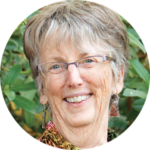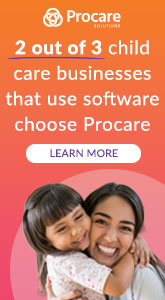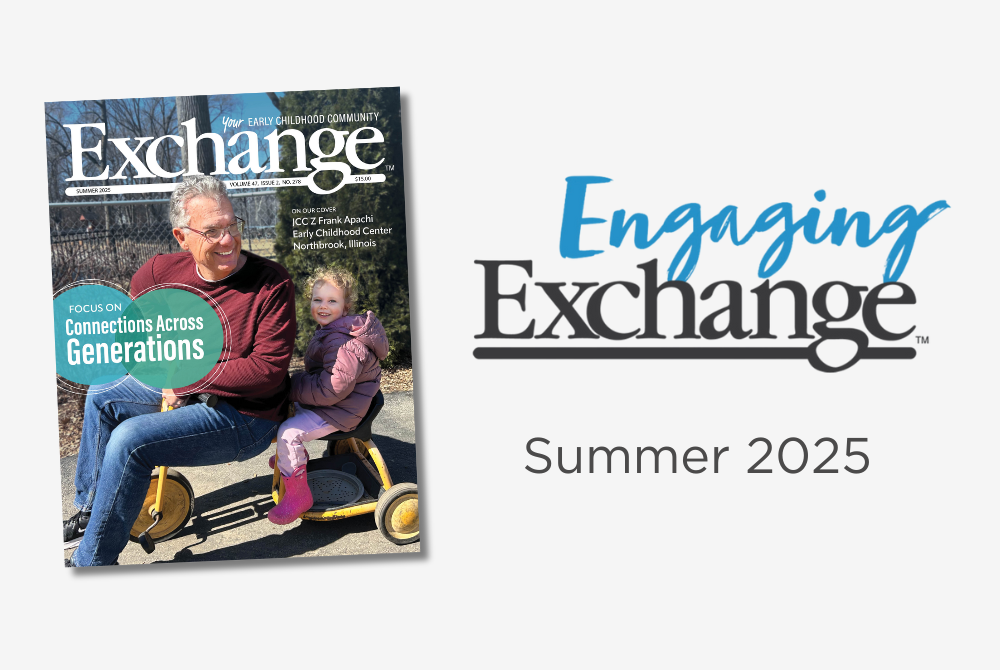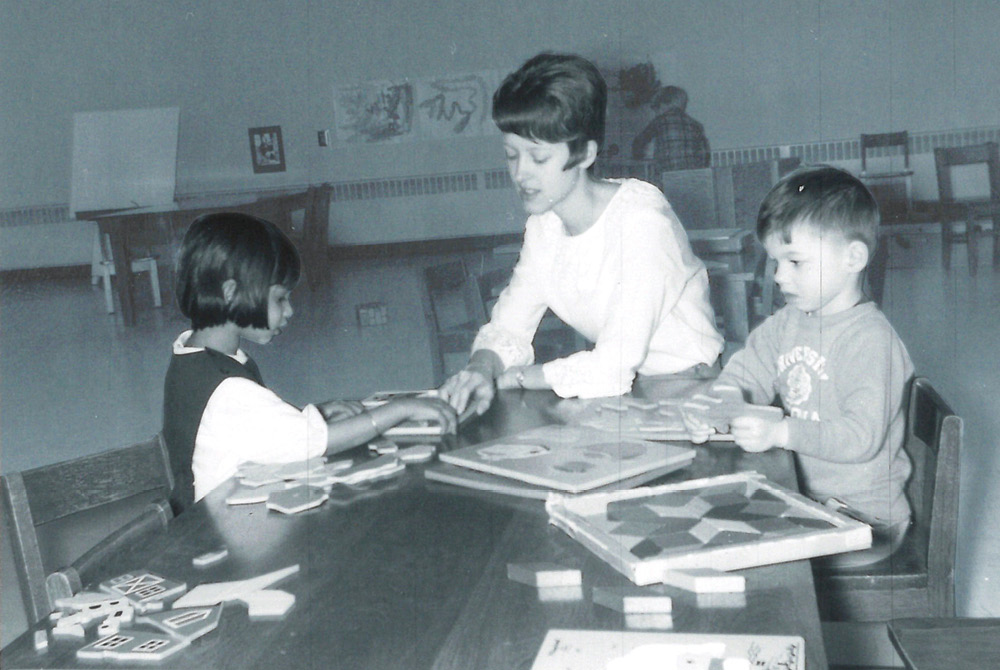People come into the early childhood field for different reasons, but all share a common desire to better the lives of children. Many are eager to offer what they missed out on in their own childhoods or conversely, to pass on favorite parts of their growing up. People may see the work as service, a calling, or perhaps an avenue for their interest in psychology, sociology, or brain development. Most people employed in early childhood see theirs as meaningful work, despite all the challenges.
I have especially loved discovering all the different ways my ECE colleagues approach working with anti-bias, social and economic justice values. In the various interviews I have done for Exchange articles over the years, you will find some terrific examples.
Working with Families
Julie Olsen Edwards says, “If you care about children, you have to care about their families, and caring about families means you have to care about the conditions in which they live and the context which shapes their lives and parenting.” ECE professionals have shown in a variety of ways how they have come to recognize bias and paternalism embedded in approaches to “parent education,” particularly for families in poverty. They’ve inspired me with examples of bringing forth parent voices, their funds of knowledge, and community leadership. (See references for my interviews with Luz Casio, “Cultivating Dispositions for Cultural Democracy” (Exchange, Nov/Dec 2010); with Paula McPheeters, “Teachers as Leaders and Activists” (Exchange, Jan/Feb 2013); and with Mary Jo Deck, “Redefining Parent Engagement” (Exchange, Nov/Dec 2015).
Moving from Gatekeeping to Empowerment
Paula McPheeters says, “Poverty is not the fault of those who suffer from it. The fault lies in the system of oppression. Our wealthy nation has the means to reverse these injustices, but it doesn’t.” I have seen creative ways ECE professionals use their positions, particularly in dealing with bureaucracies, to transform their gatekeeping role to one of engagement that leads to empowerment. (Interview with Elidia Sangerman, “Nurturing Innovation beyond Compliance” (Exchange, July/Aug 2014); with Luz Casio, “Leadership Challenges in Publicly Funded Programs” (Exchange, March/April 2016); and with Kristie Norwood, “Our Work is More Than Our Job” (Exchange, May/June 2016).
Engaging as Citizens in a Democracy
In his newest book, What Truth Sounds Like, Michael Eric Dyson (2018) says, “Only when we have the full-throated voicing of our vibrant democracy in all of its splendidly cantankerous diversity can we truly claim at last to be American.” It has been heartening to hear how teachers have taken Dewey’s idea of education for democracy into teaching practices with children. See my interview with Allison Horne, “Education for Democracy” (Exchange, March/April 2017); with Rukia Monique Rogers and Nicole Allsop, “Infusing Our Daily Work with Democratic Ideals” (Exchange, May/June 2018).
Working Cross-Culturally
While the early childhood field often reflects the socio-economic-cultural segregation of our community settings, some of us are fortunate to work in settings that cross these divides. The different experiences, values, and positions in the dynamics of privilege and racism often make this border crossing uncomfortable, if not fraught with tension. Bringing the complex dynamics out in the open for examination requires respect, trust, determination, and courage. (See my interview with Eliana Elias, “Study Tours Reveal a World of Ideas” (Nov/Dec 2016); with Julie Bisson and Theresa Lenear, “Courageous Conversations and Actions” (May/June 2017); with Ijumaa Jordan and Kelly Matthews, “Racial Justice as a Core Practice” (March/April 2018).
An Interview with Joyce Jackson and Veronica Reynoso
The various ways people bring their values to ECE work was on my mind when I started getting to know Joyce Jackson and Veronica Reynoso, two women of color, who co-teach in a school of mostly privileged children situated in an affluent neighborhood. Despite feeling “not really known,” with their life experiences so different from their co-workers and the children’s families, Jackson and Reynoso have made a deliberate choice to leave their own communities and work with privileged children, not as hired nannies in homes, but as educators in a highly respected school. I have often seen white teachers choosing to work with poor children of color in the hopes of uplifting their opportunities, perhaps thinking they could help “fix” their problems. Was there any “uplifting” or “fixing” on Jackson or Reynoso’s mind choosing this affluent workplace? As we began to get to know each other, I saw their appreciation for the kind of education these young children were privy to. I sensed the passion and dedication of these two women of different generations and cultures. We began to talk about some of their intentions for their work and I gained fuller understandings of their experiences not only with the children, but their families and co-workers.
Addressing Gender Stereotypes
Our first in-depth conversation began after I read a fascinating documentation display posted outside their classroom, focused on some of their work with the school’s anti-bias goals. The display had photos and conversation with children, along with their teacher reflections describing how an experience of creating self-portraits helps the children appreciate who they are and see their similarities and differences, the first two anti-bias goals described by Julie Olsen Edwards and Louise Derman-Sparks (2009). As they studied the children’s words they recognized underlying biases the children might have in their thinking. These teacher reflections were provocative and left me eager to talk with them further.
Margie: Your documentation revealed how you work as researchers, trying to explore children’s understandings, not just telling them what you think they need to know. As they talked about their self-portraits, you picked up on some important details in how the children had absorbed some gender stereotypes. Each day educators make choices, consciously or unconsciously, about what to pursue in their teaching. I’m guessing you chose to focus on this because you don’t want children to have limited ideas about gender.
Veronica: Gender sticks with me as an important topic to explore with children because my dad was a traditional Mexican man. He had clear ideas of what females could and could not do, and his ideas did not reflect what I believed. I’m aware that things you experience as a child shape so much of your life.
Margie: So true, and as adults, if we are self-reflective, we typically either want to pass along ideas we were taught as children, or try to counter them with how we choose to live and work.
Joyce: I’ll never get used to this idea of what boys can do or what girls can do. Why can’t we just all do what we want, regardless of our gender? I grew up hearing “that’s for boys or that’s for girls.” I learned later in life that I could choose what was for me. I wanted the same freedom for my own children. I didn’t want society choosing my norms or that of my kids.
ADVERTISEMENT
Navigating When to Research and When to Teach Concepts
Margie: I’d love to hear more about how you choose when to step in and offer more information, and when you hold back any teaching, instead wanting to understand more about children’s thinking.
Joyce: It really bothers me when children have false information about life in general. Especially when it comes to self-identity and how we see another’s identity. I don’t want the kids forming their own theories around false ideas they see or hear. I like to give accurate information as answers to their questions. It’s only fair to them, and me as well. Let’s help kids see and figure out the correct information they need. Misinformation leads to stereotypes and biases, and this isn’t fair to our kids.
Veronica: During one of our meetings with families a parent used the idea of connecting dots for children. She mentioned that giving children information is like giving children more dots to connect. The way I have interpreted this point is to recognize the more access to information children have, the easier it will be for them to connect the dots and make informed decisions. If they do not have the information, they will still try to make those connections with less information, which can lead to misconceptions about the world around them.
We give as much information as it seems they can digest, then keep the discussion open. We want to help children feel comfortable discussing their theories, so we take care to not jump in to say that what they think is wrong. That could create a roadblock in their willingness to share their thinking. I want to convey that this is something we can all learn about together.
Engaging Families
Margie: Whenever children express a stereotype or some misguided thinking, we always wonder where they got that idea. Perhaps it comes from their family context, but, for sure, it comes from our popular culture and what’s in the media airwaves. How do you engage families in thinking with you about supporting children’s healthy identity development and countering stereotypes?
Veronica: Clearly, people have different opinions. I always wonder if all our families are on board with our anti-bias goals. There may be families who vocalize a difference in opinion, but others may not because they don’t want to be seen as in conflict with the philosophy of the program. How do we make it possible for parents to feel they can approach us as teachers? Perhaps there are stickier points they or you might not fully agree with. Still, how do we say it’s OK to disagree, but let’s keep engaged and open to learning from each other?
Joyce: In one of our parent discussions we wanted to bring up the question, “Where do our kids get or form ‘negative or wrong’ information that has to do with identity and racism?” We had been having some pretty strong issues around a child not wanting to hold hands or be friendly with a child of color and the teachers of color, too. The child’s parent was feeling like she just didn’t know how to approach this subject with her child and she wanted suggestions from us.
Margie: How courageous of this parent to bring this out in the open, rather than just feeling quietly embarrassed, guilty, or wanting to avoid the fact that this was happening.
Joyce: I have to say this was a very deep and personal topic for me because it was a racism boundary and I myself was very uncomfortable with it.
Margie: And how courageous of you to decide to cross that boundary and stay engaged with the conversation, despite your discomfort, possible hurt or anger.
Joyce: I knew we needed to investigate this further and help this child who was struggling with feelings and ideas about having skin of a different color. It’s not always easy to know how to have these conversations with families. Sometimes when we write up documentation about children’s conversation that includes bias, parents feel like it reflects badly on them and they get upset at seeing their child’s name associated with this. They think this suggests they are bad or racist parents. They don’t always grasp that their child is just coming up with their own theories and ideas based on influences of the media and other stereotypes they see in books. I think children fundamentally want to know that they fit in and belong and then they pick up the idea that being different is wrong. Confusing the idea of difference with “wrong” or “bad” is where children learn to be biased about differences.
And, as Veronica was saying earlier, in the silence of us not talking about how racism works, children make up their own ideas about things and also about what our silence toward difference means. They absorb the idea that difference shouldn’t be talked about, that it’s something bad and keeps you from belonging. Everyone wants to belong. Think of a child’s point of view. She might be thinking, “Difference keeps me from doing all the fun things. I don’t want to be different.” We try to help parents understand how important it is to get all this thinking out in the open, so we can engage with it, make it normal to talk about.
Creating Classroom Culture to Explore Differences Without Judgment
Margie: Many times, we have things come up in our classrooms where it’s hard to know how to respond. We want to keep children from absorbing and expressing stereotypes or fears about difference, but we also don’t want to jump to conclusions about the meaning of what children are saying. We often need further investigation to formulate how to best respond. This is the idea of being a teacher researcher, especially when it comes to figuring out how to respond to spicy dilemmas.
Joyce: Yes, and this is also why we try to have regular family meetings, to gain more information to formulate how we want to respond. For instance, we discovered that a white child who didn’t want to hold the hand of a brown skin child was being taught in her family that everyone had to agree on family decisions; she then confused that family value with the idea that being different meant you were in disagreement and therefore wrong. Once we better understood what her confusions were, we knew how to have conversations and find books that helped her thinking.
Margie: Wow, Joyce, I’m so impressed with how you kept probing for understandings. When a white child rejects your hand because it is dark brown, you could have just been so hurt or angry that you disengaged.
Joyce: I was determined to help this little girl recognize and be comfortable with how people can be different. I chose to become her close friend to help her with her issues about my skin color and her relationships with the other children and teachers of color.
Veronica: We’ve had children express ideas that a princess means you can only be white, having long blond hair and blue eyes. We’ve been learning ways to point out contradictions in their thinking, to put them in a situation where they have more personal connections that will create empathy. When we put people they know, love and respect, in the context of injustice, these personal connections, like with playmates or teachers, help children better grasp the concept of injustice. They can empathize with what it feels like to be treated unfairly. We want children to follow our lead in becoming cultural ambassadors. They will learn to speak up when something is unfair. We try to create a classroom culture of caring about each other, of learning to speak up when someone is hurt or treated unfairly so that it becomes a natural thing to do.
Choosing to Work with Advantaged Children
Margie: I’m struck by the choice that each of you has made to work in a program with privileged children and families. Your dedication is quite obvious, as well as inspiring, but there must be some frustrations and moments of impatience with the blind spots of people who live with advantages in a system of inequality.
Joyce: Yes, that’s true. Here I am with all these little kids who don’t know about my world. They don’t know it isn’t all a bed of roses, even though it might be at their house. At first, I felt very uncomfortable with my choice to work at this new school. I felt out of place and was sometimes treated that way. The experiences we’ve been describing made me more confident and more determined to stay here. I want to open up a window for these privileged children to see into the real world for people of color. I want to help them see what unfairness and fairness look like, help bring an understanding that yes, we all have differences, but being different doesn’t mean that we shouldn’t be treated with the same fairness as others. I want them to consider that even though we may be different, we can still be friends.
I want to help children understand that we all need to speak up when we see these unfair behaviors going on. We talk about feelings: How would this make you feel if we couldn’t be friends? How would you feel if I could have ice cream and you couldn’t because your skin isn’t the same color as mine or because you’re a boy and I’m a girl? Let’s talk about this!
Joyce: When I was taking my college courses in the 1990s, I asked my grandmother questions about all the racial and civil rights issues that she grew up with. I was expressing to her that the same things from back then were still going on. Her response was, “That’s because times change and people don’t.” I told my Gramma that this was the reason I was going to be a teacher so that people will change.
I would love to see more teachers of color in schools like this. This is exactly what these types of privileged schools need. I want teachers of color to step out of their comfort zones and do something outside of their own communities. As we open up our lives and experiences for these privileged kids to learn about, we will hopefully help them become more responsible as they grow older. They will learn to see that they are social justice advocates who want to shape a world where fairness, equality and equity are top priorities in their lives. By sharing my work experiences with other teachers of color, I’m hoping that they will not be intimidated by working at schools such as this one. We need more teachers of color in these schools!
Veronica: If more people of color work in privileged schools, other families of color will come so that their children get the same quality experience. Education will become equitable. We definitely need more families of color to see their children belong in high-quality programs. I hope my work will inspire that.
Margie: We decided to call this article “What needs fixing?” because Veronica, you pointed out that people of color are often viewed as “needing fixing,” when, really, the segregation and inequities built into our educational systems are what need fixing. In the name of “fixing” poor children, often children of color, schools subject them to a regimented, drill-and-kill education, while more privileged children are afforded rich, engaging play opportunities for their brain development. Advantaged children, usually white, are offered educational experiences where they learn the skills of innovation, problem solving, and critical thinking. They are receiving a far greater head start in accessing the highways of power and privilege. Thank you, Joyce and Veronica, for your generosity, your sensitivities, your sacrifices, and indeed, the courageous boldness of your choices.
References
Dyson, M. (2018). What Truth Sounds Like. New York: St Martin’s Press
Carter, M. (May/June 2016), interview with Kristie Norwood, Our Work is More Than Our Job. Redmond: Exchange Press.
Carter, M. (March/April 2017), interview with Allison Horne, Education for Democracy. Redmond: Exchange Press.
Carter, M. (May/June 2017), interview with Julie Bisson and Theresa Lenear, Courageous Conversations and Actions. Redmond: Exchange Press.
Carter, M. (March/April 2014), interview with Guille Lopez and Sadie Cunningham, Cross Cultural Team Work. Redmond: Exchange Press.
Carter, M. (May June 2018). Rukia Monique Rogers and Nicole Allsop, Infusing Our Daily Work with Democratic Ideals. Redmond: Exchange Press.
Carter, M. (July/Aug 2014), interview with Elidia Sangerman, Nurturing Innovation beyond Compliance. Redmond: Exchange Press
Carter, M. (Nov/Dec 2013), interview with Eliana Elias, “Study Tours Reveal a World of Ideas”. Redmond: Exchange Press.
Carter, M. (March/April 2018), interview with Ijumaa Jordan and Kelly Matthews, “Racial Justice as a Core Practice”. Redmond: Exchange Press.
Olsen Edwards, J. & Derman-Sparks,L. (2009). Anti bias Education for Children and Ourselves. Washington, D.C.: NAEYC.
Related
ADVERTISEMENT













